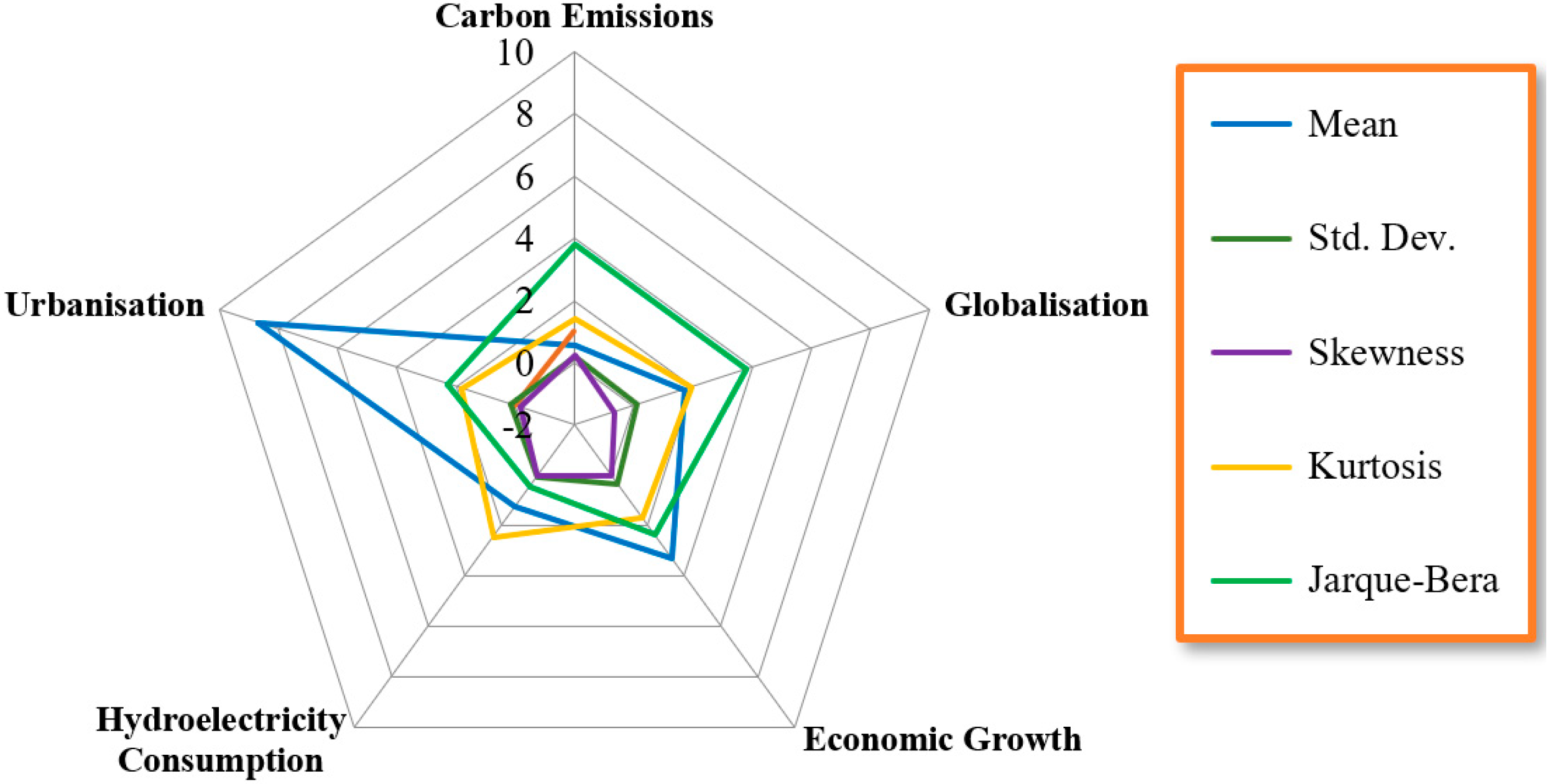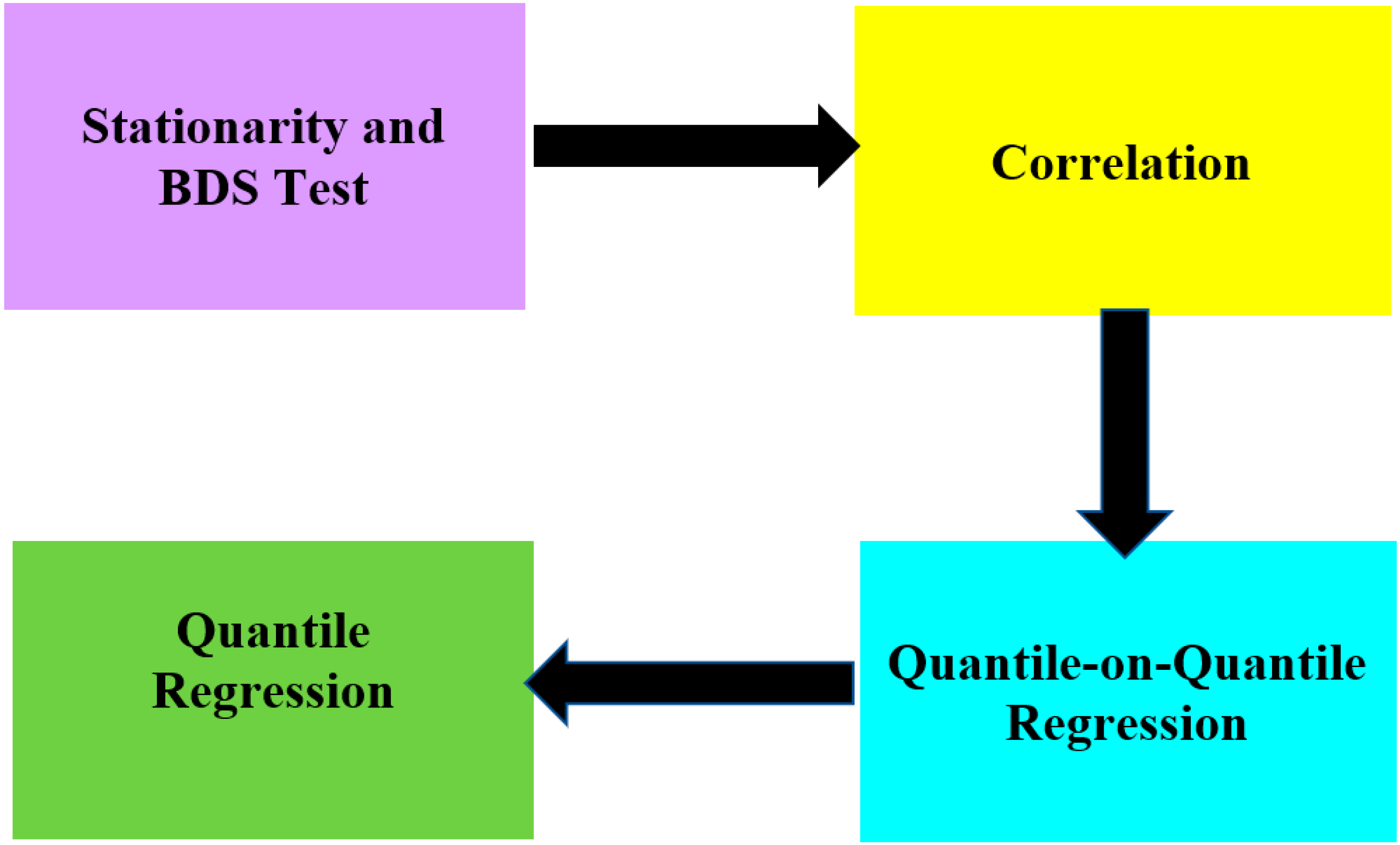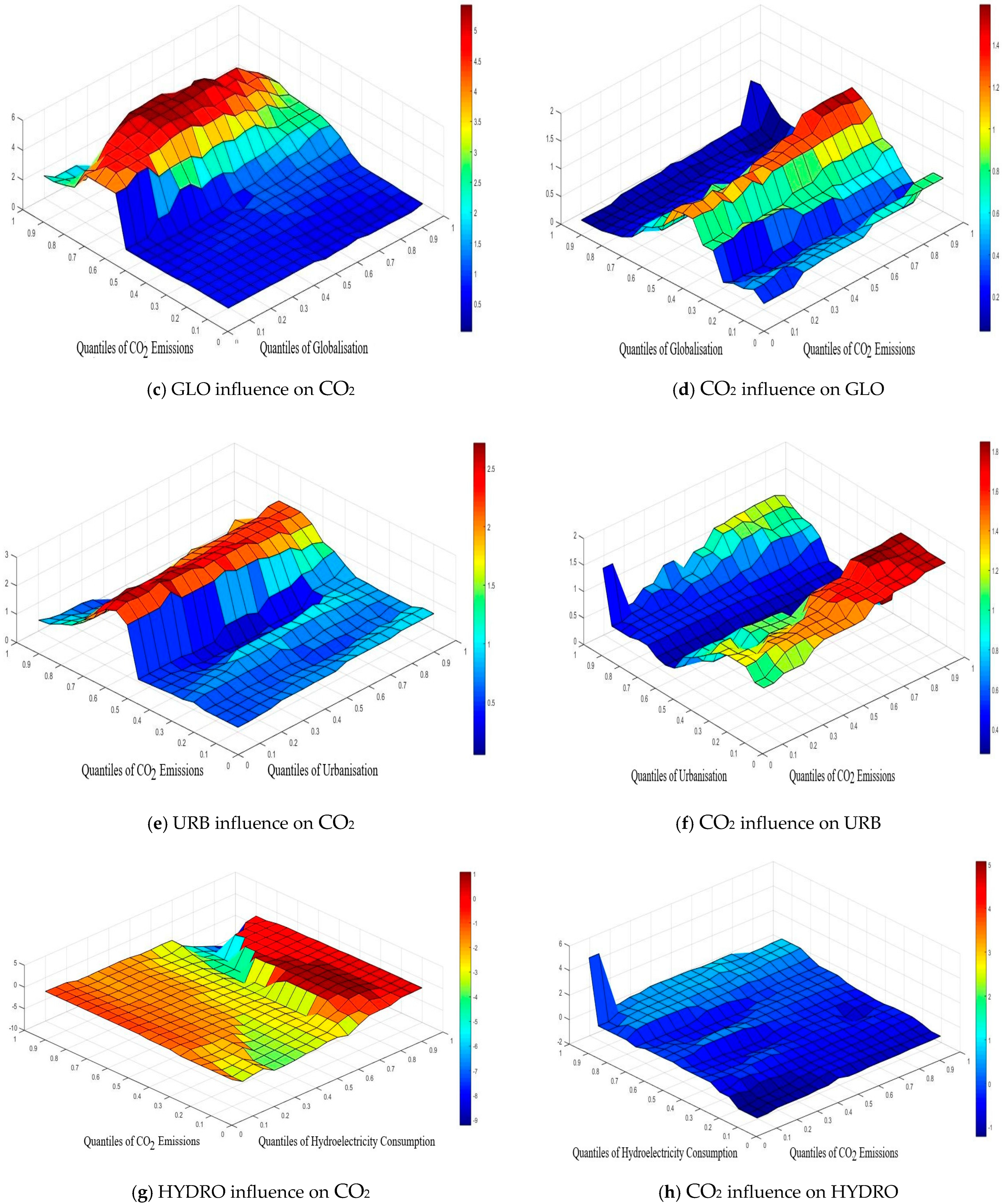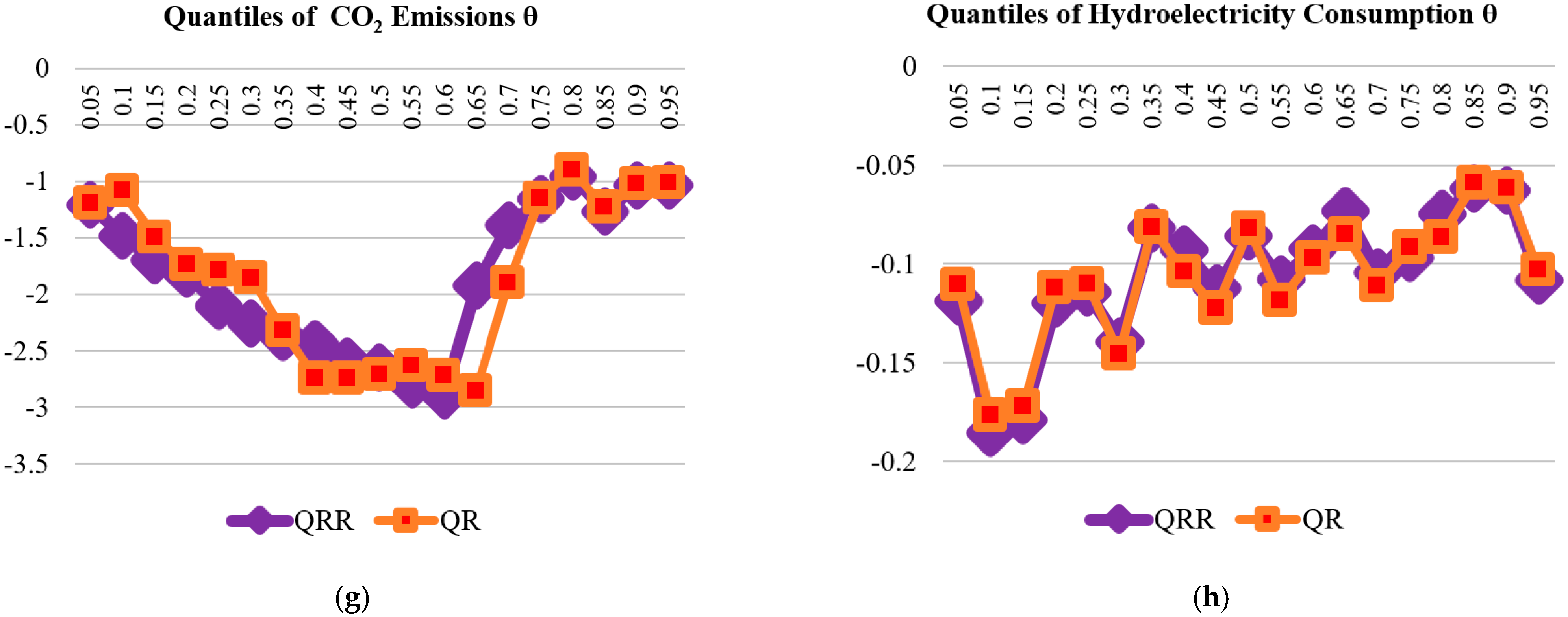Towards Environmental Sustainability in China: Role of Globalization and Hydroelectricity Consumption
Abstract
:1. Introduction
2. Literature Review
2.1. GDP and CO2 Interrelationship
2.2. CO2 and Globalization
2.3. CO2 and Hydroelectricity Consumption
2.4. CO2 and Urbanization
3. Data and Methodology
3.1. Data
3.2. Methodology
4. Findings and Discussion
5. Conclusions and Policy Direction
Author Contributions
Funding
Institutional Review Board Statement
Informed Consent Statement
Data Availability Statement
Conflicts of Interest
References
- Soylu, Ö.B.; Adebayo, T.; Kirikkaleli, D. The Imperativeness of Environmental Quality in China Amidst Renewable Energy Consumption and Trade Openness. Sustainability 2021, 13, 5054. [Google Scholar] [CrossRef]
- Adebayo, T.S.; Rjoub, H.; Akadiri, S.S.; Oladipupo, S.D.; Sharif, A.; Adeshola, I. The role of economic complexity in the environmental Kuznets curve of MINT economies: Evidence from method of moments quantile regression. Environ. Sci. Pollut. Res. 2021, 18, 1–13. [Google Scholar] [CrossRef] [PubMed]
- Acheampong, A.; Boateng, E.B. Modelling carbon emission intensity: Application of artificial neural network. J. Clean. Prod. 2019, 225, 833–856. [Google Scholar] [CrossRef]
- Koengkan, M.; Fuinhas, J.A.; Santiago, R. Asymmetric impacts of globalisation on CO2 emissions of countries in Latin America and the Caribbean. Environ. Syst. Decis. 2019, 40, 135–147. [Google Scholar] [CrossRef]
- Leal, P.H.; Marques, A.C. The environmental impacts of globalisation and corruption: Evidence from a set of African countries. Environ. Sci. Policy 2020, 115, 116–124. [Google Scholar] [CrossRef]
- Gygli, S.; Haelg, F.; Potrafke, N.; Sturm, J.-E. The KOF Globalisation Index–revisited. Rev. Int. Organ. 2019, 14, 543–574. [Google Scholar] [CrossRef] [Green Version]
- Adebayo, T.S.; Kirikkaleli, D. Impact of renewable energy consumption, globalization, and technological innovation on environmental degradation in Japan: Application of wavelet tools. Environ. Dev. Sustain. 2021, 23, 16057–16082. [Google Scholar] [CrossRef]
- Adebayo, T.S.; Awosusi, A.A.; Kirikkaleli, D.; Akinsola, G.D.; Mwamba, M.N. Can CO2 emissions and energy consumption determine the economic performance of South Korea? A time series analysis. Environ. Sci. Pollut. Res. 2021, 28, 38969–38984. [Google Scholar] [CrossRef]
- Bekun, F.V.; Alola, A.A.; Gyamfi, B.A.; Yaw, S.S. The relevance of EKC hypothesis in energy intensity real-output trade-off for sustainable environment in EU-27. Environ. Sci. Pollut. Res. 2021, 28, 51137–51148. [Google Scholar] [CrossRef]
- He, X.; Adebayo, T.S.; Kirikkaleli, D.; Umar, M. Consumption-based carbon emissions in Mexico: An analysis using the dual adjustment approach. Sustain. Prod. Consum. 2021, 27, 947–957. [Google Scholar] [CrossRef]
- Adebayo, T.S.; Akinsola, G.D.; Odugbesan, J.A.; Olanrewaju, V.O. Determinants of Environmental Degradation in Thailand: Empirical Evidence from ARDL and Wavelet Coherence Approaches. Pollution 2021, 7, 181–196. [Google Scholar] [CrossRef]
- Solarin, S.A.; Al-Mulali, U.; Musah, I.; Ozturk, I. Investigating the pollution haven hypothesis in Ghana: An empirical investigation. Energy 2017, 124, 706–719. [Google Scholar] [CrossRef]
- Adebayo, T.S.; Rjoub, H.; Akinsola, G.D.; Oladipupo, S.D. The asymmetric effects of renewable energy consumption and trade openness on carbon emissions in Sweden: New evidence from quantile-on-quantile regression approach. Environ. Sci. Pollut. Res. 2021, 29, 1875–1886. [Google Scholar] [CrossRef] [PubMed]
- BP. British Petroleum. Available online: https://www.bp.com/content/dam/bp/business-sites/en/global/corporate/pdfs/energy-economics/statistical-review/bp-stats-review-2019-china-insights.pdf (accessed on 30 May 2021).
- Tiwari, A.K.; Shahbaz, M.; Hye, Q.M.A. The environmental Kuznets curve and the role of coal consumption in India: Cointegration and causality analysis in an open economy. Renew. Sustain. Energy Rev. 2013, 18, 519–527. [Google Scholar] [CrossRef] [Green Version]
- Tufail, M.; Song, L.; Adebayo, T.S.; Kirikkaleli, D.; Khan, S. Do fiscal decentralization and natural resources rent curb carbon emissions? Evidence from developed countries. Environ. Sci. Pollut. Res. 2021, 28, 49179–49190. [Google Scholar] [CrossRef]
- Sarkodie, S.A.; Adams, S. Renewable energy, nuclear energy, and environmental pollution: Accounting for political institutional quality in South Africa. Sci. Total Environ. 2018, 643, 1590–1601. [Google Scholar] [CrossRef]
- Magazzino, C. The relationship among economic growth, CO2 emissions, and energy use in the APEC countries: A panel VAR approach. Environ. Syst. Decis. 2017, 37, 353–366. [Google Scholar] [CrossRef]
- Adebayo, T.S.; Akadiri, S.S.; Adedapo, A.T.; Usman, N. Does interaction between technological innovation and natural resource rent impact environmental degradation in newly industrialized countries? New evidence from method of moments quantile regression. Environ. Sci. Pollut. Res. 2021, 29, 3162–3169. [Google Scholar] [CrossRef]
- Alola, A.A.; Adebayo, T.S.; Onifade, S.T. Examining the dynamics of ecological footprint in China with spectral Granger causality and quantile-on-quantile approaches. Int. J. Sustain. Dev. World Ecol. 2021, 29, 263–276. [Google Scholar] [CrossRef]
- Ahmed, Z.; Le, H.P. Linking Information Communication Technology, trade globalization index, and CO2 emissions: Evidence from advanced panel techniques. Environ. Sci. Pollut. Res. 2020, 28, 8770–8781. [Google Scholar] [CrossRef]
- Adebayo, T.S.; Kirikkaleli, D.; Adeshola, I.; Oluwajana, D.; Akinsola, G.D.; Osemeahon, O.S. Coal Consumption and Environmental Sustainability in South Africa: The role of Financial Development and Globalization. Int. J. Renew. Energy Dev. 2021, 10, 527–536. [Google Scholar] [CrossRef]
- Bekun, F.V.; Emir, F.; Sarkodie, S.A. Another look at the relationship between energy consumption, carbon dioxide emissions, and economic growth in South Africa. Sci. Total Environ. 2019, 655, 759–765. [Google Scholar] [CrossRef] [PubMed]
- Zhang, L.; Li, Z.; Kirikkaleli, D.; Adebayo, T.S.; Adeshola, I.; Akinsola, G.D. Modeling CO2 emissions in Malaysia: An application of Maki cointegration and wavelet coherence tests. Environ. Sci. Pollut. Res. 2021, 28, 26030–26044. [Google Scholar] [CrossRef] [PubMed]
- Rahman, M.M. Environmental degradation: The role of electricity consumption, economic growth and globalisation. J. Environ. Manag. 2020, 253, 109742. [Google Scholar] [CrossRef]
- Kirikkaleli, D.; Adebayo, T.S.; Khan, Z.; Ali, S. Does globalization matter for ecological footprint in Turkey? Evidence from dual adjustment approach. Environ. Sci. Pollut. Res. 2020, 28, 14009–14017. [Google Scholar] [CrossRef]
- Shahbaz, M.; Sharma, R.; Sinha, A.; Jiao, Z. Analyzing nonlinear impact of economic growth drivers on CO2 emissions: Designing an SDG framework for India. Energy Policy 2020, 148, 111965. [Google Scholar] [CrossRef]
- Usman, O.; Akadiri, S.S.; Adeshola, I. Role of renewable energy and globalization on ecological footprint in the USA: Implications for environmental sustainability. Environ. Sci. Pollut. Res. 2020, 27, 30681–30693. [Google Scholar] [CrossRef]
- Lau, L.-S.; Choong, C.-K.; Ng, C.-F.; Liew, F.-M.; Ching, S.-L. Is nuclear energy clean? Revisit of Environmental Kuznets Curve hypothesis in OECD countries. Econ. Model. 2018, 77, 12–20. [Google Scholar] [CrossRef]
- Bello, M.O.; Solarin, S.A.; Yen, Y.Y. The impact of electricity consumption on CO2 emission, carbon footprint, water footprint and ecological footprint: The role of hydropower in an emerging economy. J. Environ. Manag. 2018, 219, 218–230. [Google Scholar] [CrossRef]
- Adebayo, T.S.; Akadiri, S.S.; Akpan, U.; Aladenika, B. Asymmetric effect of financial globalization on carbon emissions in G7 countries: Fresh insight from quantile-on-quantile regression. Energy Environ. 2022, 3, 45–61. [Google Scholar] [CrossRef]
- Wang, J.; Xu, Y. Internet Usage, Human Capital and CO2 Emissions: A Global Perspective. Sustainability 2021, 13, 8268. [Google Scholar] [CrossRef]
- Rahman, M.M.; Vu, X.-B. The nexus between renewable energy, economic growth, trade, urbanisation and environmental quality: A comparative study for Australia and Canada. Renew. Energy 2020, 155, 617–627. [Google Scholar] [CrossRef]
- Yazdi, S.K.; Beygi, E.G. The dynamic impact of renewable energy consumption and financial development on CO2 emissions: For selected African countries. Energy Sources Part B Econ. Plan. Policy 2017, 13, 13–20. [Google Scholar] [CrossRef]
- Ling, G.; Razzaq, A.; Guo, Y.; Fatima, T.; Shahzad, F. Asymmetric and time-varying linkages between carbon emissions, globalization, natural resources and financial development in China. Environ. Dev. Sustain. 2021, 4, 1–29. [Google Scholar] [CrossRef] [PubMed]
- Khan, Z.; Ali, S.; Umar, M.; Kirikkaleli, D.; Jiao, Z. Consumption-based carbon emissions and International trade in G7 countries: The role of Environmental innovation and Renewable energy. Sci. Total Environ. 2020, 730, 138945. [Google Scholar] [CrossRef]
- Zhang, J.; Dai, Y.; Su, C.-W.; Kirikkaleli, D.; Umar, M. Intertemporal change in the effect of economic growth on carbon emission in China. Energy Environ. 2021, 32, 1207–1225. [Google Scholar] [CrossRef]
- Koenker, R.; Bassett, G. Regression Quantiles. Econometrica 1978, 46, 33–50. [Google Scholar] [CrossRef]
- Sim, N.; Zhou, H. Oil prices, US stock return, and the dependence between their quantiles. J. Bank. Financ. 2015, 55, 1–8. [Google Scholar] [CrossRef]
- Adebayo, T.S.; Oladipupo, S.D.; Adeshola, I.; Rjoub, H. Wavelet analysis of impact of renewable energy consumption and technological innovation on CO2 emissions: Evidence from Portugal. Environ. Sci. Pollut. Res. 2021, 2, 1–18. [Google Scholar] [CrossRef]
- Adebayo, T.S.; Udemba, E.N.; Ahmed, Z.; Kirikkaleli, D. Determinants of consumption-based carbon emissions in Chile: An application of non-linear ARDL. Environ. Sci. Pollut. Res. 2021, 28, 43908–43922. [Google Scholar] [CrossRef]
- Kirikkaleli, D.; Adebayo, T.S. Do public-private partnerships in energy and renewable energy consumption matter for consumption-based carbon dioxide emissions in India? Environ. Sci. Pollut. Res. 2021, 28, 30139–30152. [Google Scholar] [CrossRef] [PubMed]
- Kirikkaleli, D.; Adebayo, T.S. Do renewable energy consumption and financial development matter for environmental sustainability? New global evidence. Sustain. Dev. 2020, 29, 583–594. [Google Scholar] [CrossRef]
- Adebayo, T.S.; Acheampong, A.O. Modelling the globalization-CO2 emission nexus in Australia: Evidence from quantile-on-quantile approach. Environ. Sci. Pollut. Res. 2021, 29, 9867–9882. [Google Scholar] [CrossRef] [PubMed]
- Adebayo, T.S.; Agyekum, E.B.; Altuntaş, M.; Khudoyqulov, S.; Zawbaa, H.M.; Kamel. Does information and communication technology impede environmental degradation? fresh insights from non-parametric approaches. Heliyon 2022, 3, 22–35. [Google Scholar] [CrossRef]
- Xu, Z.; Baloch, M.A.; Danish; Meng, F.; Zhang, J.; Mahmood, Z. Nexus between financial development and CO2 emissions in Saudi Arabia: Analyzing the role of globalization. Environ. Sci. Pollut. Res. 2018, 25, 28378–28390. [Google Scholar] [CrossRef]
- Ulucak, Z.S.; Yucel, A.G. Can renewable energy be used as an effective tool in the decarbonization of the Mediterranean region: Fresh evidence under cross-sectional dependence. Environ. Sci. Pollut. Res. 2021, 28, 52082–52092. [Google Scholar] [CrossRef]
- Umar, M.; Ji, X.; Kirikkaleli, D.; Xu, Q. COP21 Roadmap: Do innovation, financial development, and transportation infrastructure matter for environmental sustainability in China? J. Environ. Manag. 2020, 271, 111026. [Google Scholar] [CrossRef]
- Yuping, L.; Ramzan, M.; Xincheng, L.; Murshed, M.; Awosusi, A.A.; Bah, S.I.; Adebayo, T.S. Determinants of carbon emissions in Argentina: The roles of renewable energy consumption and globalization. Energy Rep. 2021, 7, 4747–4760. [Google Scholar] [CrossRef]
- Chen, Y.; Wang, Z.; Zhong, Z. CO2 emissions, economic growth, renewable and non-renewable energy production and foreign trade in China. Renew. Energy 2018, 131, 208–216. [Google Scholar] [CrossRef]
- IEA. International Energy Association. 2021. Available online: https://www.iea.org/countries/sweden (accessed on 1 June 2021).
- Cherni, A.; Jouini, S.E. An ARDL approach to the CO2 emissions, renewable energy and economic growth nexus: Tunisian evidence. Int. J. Hydrog. Energy 2017, 42, 29056–29066. [Google Scholar] [CrossRef]






| Probability | CO2 | GLO | GDP | HYD | URB |
|---|---|---|---|---|---|
| CO2 | 1.0000 | ||||
| GLO | 0.9029 * | 1.0000 | |||
| GDP | 0.9765 * | 0.9536 * | 1.0000 | ||
| HYD | −0.4717 * | −0.6700 * | −0.4983 * | 1.0000 | |
| URB | 0.9623 * | 0.9729 * | 0.9962 * | −0.5429 * | 1.0000 |
| CO2 | URB | GLO | GDP | HYD | |
|---|---|---|---|---|---|
| M2 | 21.847 * | 28.171 * | 19.632 * | 28.511 * | 11.690 * |
| M3 | 22.161 * | 29.279 * | 20.642 * | 29.295 * | 11.283 * |
| M4 | 22.640 * | 31.053 * | 21.921 * | 30.732 * | 10.355 * |
| M5 | 23.734 * | 33.997 * | 23.806 * | 33.264 * | 10.088 * |
| M6 | 25.299 * | 38.152 * | 26.654 * | 37.106 * | 10.387 * |
| I(0) | I(1) | |||
|---|---|---|---|---|
| Variables | t-Stat | BY | t-Statistic | BY |
| CO2 | −3.3681 | 1996 | −5.701 * | 2003 |
| URB. | −1.7521 | 2004 | −6.024 * | 2002 |
| GDP | −4.2174 | 2009 | −5.295 ** | 2005 |
| GLO | −3.2616 | 2004 | −6.178 ** | 2008 |
| HYD | −4.0322 | 2012 | −5.835 * | 2012 |
Publisher’s Note: MDPI stays neutral with regard to jurisdictional claims in published maps and institutional affiliations. |
© 2022 by the authors. Licensee MDPI, Basel, Switzerland. This article is an open access article distributed under the terms and conditions of the Creative Commons Attribution (CC BY) license (https://creativecommons.org/licenses/by/4.0/).
Share and Cite
Özbay, R.D.; Athari, S.A.; Saliba, C.; Kirikkaleli, D. Towards Environmental Sustainability in China: Role of Globalization and Hydroelectricity Consumption. Sustainability 2022, 14, 4182. https://doi.org/10.3390/su14074182
Özbay RD, Athari SA, Saliba C, Kirikkaleli D. Towards Environmental Sustainability in China: Role of Globalization and Hydroelectricity Consumption. Sustainability. 2022; 14(7):4182. https://doi.org/10.3390/su14074182
Chicago/Turabian StyleÖzbay, Rahmi Deniz, Seyed Alireza Athari, Chafic Saliba, and Dervis Kirikkaleli. 2022. "Towards Environmental Sustainability in China: Role of Globalization and Hydroelectricity Consumption" Sustainability 14, no. 7: 4182. https://doi.org/10.3390/su14074182









